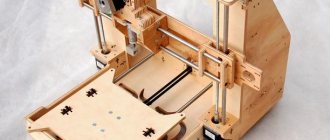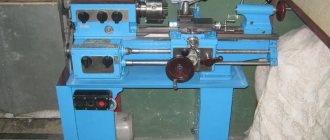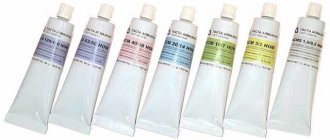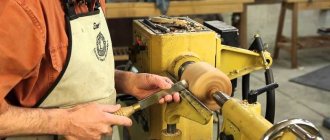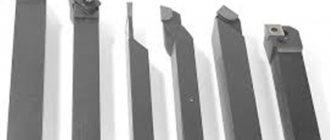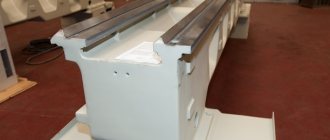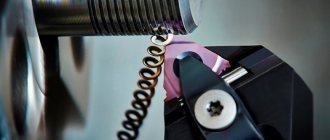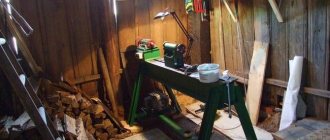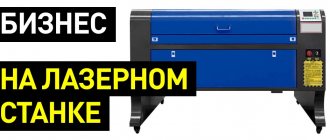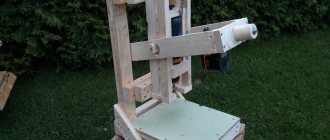Equipment design
Combining a drilling and milling machine together is easy. The design of single-rack models of both types of equipment is the same. The tool rotates and processes the part fixed on the table. Main nodes:
A tabletop drilling and milling machine has a low and flat base. Floor-standing types have cabinets. A support with a spindle rises and falls along a vertical column. There is a gear rack on the rack, the gear is mounted on the spindle assembly. Torque is transmitted from the electric motor to the tool. The vertical movement of the rotating tool occurs due to the movement of the support along the column. The horizontal movement of the spindle head is carried out along the guides of the support perpendicular to the movement of the table. The tool, cutters and drills are attached to the spindle using a chuck.
The workpiece is placed on the table and secured with bolts and nuts. T-slots in the slab are used. Small and complex-shaped workpieces are fixed in a vice, which is included in the set of drilling and milling equipment.
A CNC drilling and milling machine is suitable for performing similar operations and manufacturing a large number of complex parts. The operator types in a program, according to which the machine then operates independently. You can connect your computer to a small desktop drilling and milling equipment. Numerical control expands the capabilities of the machine. The part is processed on 3 sides. Splines and ridges are cut. Cutting splines on long shaft-type parts is carried out using a spindle and a support mounted on the table.
How to make a milling machine from a drilling machine
An electric drill is a versatile tool. In addition to being used for its intended purpose (drilling holes), it can be used for many types of work. After all, the drill chuck allows you to clamp not only drills, but also cutters, grinding elements and even wooden workpieces for turning. Therefore, from this tool you can make several types of full-fledged home machines for processing and manufacturing various materials and parts.
Features of the use of machines
Working with a drill while holding the tool only with your hands significantly limits its capabilities. The weight of the tool and vibration do not allow the drill to be firmly fixed in the desired position. But if you think through and design a special frame where it will be firmly attached, then an ordinary hand drill will turn into professional, almost industrial equipment.
From a drill you can make the following types of machines yourself:
Moreover, after replacing the working or cutting element, the machines become interchangeable. They provide a two-in-one function, for example, a drilling and milling machine, a lathe and a grinder. It all depends on the installation conditions and the needs of the owner.
The power of the machines and their capabilities will depend on the type of drill (the power of its electric motor), the method of fastening, since in this case it is the main working part of the equipment.
Types of machines
Despite the homemade assembly, each machine allows the production of a wide range of parts of varying complexity and configuration. If the unit is installed correctly, it will be practically inferior to professional factory analogues in terms of accuracy and speed of operation.
If you use a high-power drill, designed for long-term uninterrupted operation, then on such a machine it is possible to set up mass production or processing of various elements.
At home, such machines can fully satisfy household needs for repairing furniture, cars, bicycles and many other everyday items. They will help you implement many design solutions without the need to contact specialized workshops.
Each type of machine provides for the performance of different jobs and has its own characteristics.
Drilling
A drilling machine is necessary for forming holes in various surfaces - both flat and multifaceted elements made of wood, metal, plastic, glass. The diameter of the hole and the material of the part are determined by the type of cutting element used - drill.
The principle of operation of the unit is based on the fact that the mechanism that provides the torque of the cutting element (in our case, a drill) is located directly perpendicular to the surface being processed on a special bed - a spindle mounted on a stand. When the spindle is lowered, the drill enters the surface and makes a hole in it.
The main advantage of working on a machine over manual processing is that the hole is more accurate .
The attached drill can be clearly focused and directed to the desired location.
Purpose of drilling and milling machines
On a milling and drilling machine, a part is processed from one installation, drilling and milling operations are carried out along a plane. The equipment is intended for the production of spare parts that are in demand when repairing machines and various mechanisms, and for the independent creation of original devices. In private workshops it is possible to produce small batches of parts. At enterprises with mass production of products, combined models such as drilling and milling equipment are not used, or floor-mounted CNC units are installed.
The following operations are performed on milling and boring machines:
- drilling;
- milling;
- boring;
- countersinking;
- thread cutting;
- selection of grooves;
- spline milling;
- cutting combs.
The use of conical and disk-shaped flap wheels allows grinding along the plane and inside holes on drilling and milling equipment. Circles designed for grinders and routers are installed.
To perform operations, the tool changes, depending on the type of processing. FS 1, a tabletop drilling and milling machine, is popular in repair shops and private entrepreneurs. It is designed for processing workpieces up to 200 mm high and 450 mm long. It is used for drilling, tapping and milling along planes, including ends. FS 1 has manual control. Rotation from the motor to the spindle is transmitted by belts.
Read also: Metal shelf bracket
The following types of parts are manufactured using drilling and milling equipment:
The precision of milling and the cleanliness of processing allow us to make templates of various configurations for processing metal and wooden parts using copiers. The following grooves are made using shaped cutters:
When connected to a CNC machine, splines are cut on the shafts, gear racks and fastening bolts with figured heads are made for the grooves on the plates.
Drilling and milling machines can process gypsum, stone, and wood in addition to metal. They are used in construction when laying communication routes. The equipment is suitable for cutting ventilation holes, tapping threads in fittings, and making recesses in bricks.
How to operate a drilling machine
Proper operation of a drilling machine involves the safe performance of various operations, the list of which is determined by the functionality of a particular model. To prevent injury due to failure to comply with safety requirements, it is necessary to know the hazardous areas of the equipment and how to operate it.
In this article you will learn how to avoid dangers when using a drilling machine, as well as how to make precise holes and work with hard materials. This information will be useful to those who are planning to order or have just purchased a drilling machine.
Connection
One of the main danger zones of a drilling unit is electrical. It includes a motor, starting devices and a ground contact. If there is any malfunction in this part of the machine, you can get an electric shock. To prevent this from happening, you first need to properly connect the machine to the network.
In production conditions, the task of connecting the installation to the electrical network is solved by specialists. Home craftsmen often do everything themselves, although it is better to turn to an electrician.
When connecting the drilling machine yourself, it is important to strictly follow the instructions in the operating manual. Let's take a 350 W household model as an example. Manufacturers recommend using a three-core copper cable with a wire cross-section of 1.5 mm2 to power it. In addition, you need to install a 10 A circuit breaker in the network. The drilling machine cord must be connected to an outlet with mandatory grounding.
Preparing for work
Take your time to turn on the machine. Go through the preparatory stage, which will help you get to work fully equipped:
- Put on work clothes. In production, this is usually a suit or robe. The function of such clothing is to protect the operator from chips, cutting fluid, and dust. At home, you can use some old things for work, but it is more practical to purchase workwear: durable, easy to clean and not restrict movement. Please note that the sleeve cuffs should fit snugly to the arm, and the shirt should be tucked in to prevent the edges of the clothing from accidentally catching on the moving parts of the machine. For the same reason, it is recommended to hide your hair under a hat.
- Install the drill into the spindle of the unit. The engine must be turned off. The equipment must be secured as securely as possible. The strongest clamp is considered to be a Morse taper (a cutting tool with a shank is installed directly into the spindle), because the crimping area of this design is larger compared to fixing it in a chuck. If the chuck is key, before each turn on, check that the key is removed, otherwise, when the spindle rotates, it will fly off at high speed.
- Maintain alignment between spindle and drill. If, when you turn on the machine, you notice that the tip of the cutting tool rotates, describing a circle, this indicates an incorrect installation. Turn off the power and adjust the position of the drill. Firstly, by doing so you will eliminate the possibility of the equipment flying out; secondly, ensure the accuracy of the work.
- Install the workpiece. Did you know that 1 in 4 times the operator holding the workpiece with his hand is injured? Secure the part so that you do not have to hold it while working. To completely eliminate movement of the part during drilling, use a vice, clamps, or prisms. These devices must be firmly secured to the table to prevent the workpiece from moving.
- Wear safety glasses. Do this before turning on the machine. The fact is that at the moment when the drill touches the workpiece, dust and chips fly out of the working area, which can get into your eyes. This often happens when working without eye protection, despite the fact that almost all models of drilling equipment are equipped with a protective transparent shield.
Expert advice
To start working, turn on the machine. When the spindle reaches the desired speed, slowly move the drill towards the workpiece. The pressure on the handle should be increased gradually and reduced before finishing drilling. This will help avoid equipment breakdown. Once you have a hole, raise the spindle and only then turn off the machine engine.
Beginner users often do not know how to make a through hole. To do this, you need to place a wooden block under the part to ensure the safety of the cutting tool and not damage the work table.
If you need to drill a deep hole, you will need to remove the tool from the workpiece from time to time to cool it with cutting fluid. Otherwise, the cutting tool will become very hot during processing, which may cause wear or even failure.
Does your equipment have no coolant? Instead, you can dip the drill bit into any container of cutting fluid. In addition, during the process of forming deep holes, the equipment must be periodically removed to free the unfinished hole from chips - this helps to avoid jamming of the drill.
To get the most accurate hole, mark its center in advance. To do this, use a special hand tool - a punch. To ensure precision drilling of holes with a diameter of more than 5 mm, first work with a thin drill, then drill out the material to the required size.
It will be easier to process metal if you pre-lubricate the equipment. In a home workshop, machine oil can be used as a lubricant. In production, special compounds are used for this purpose.
What to remember when working:
- Do not tilt your head close to the drilling tool;
- Do not cool the drill with a wet cloth;
- Do not stop the spindle by hand.
After work
When finished working, turn off the engine and remove the finished part. Be sure to clean the drilling machine from chips and dust using a brush. Debris stuck in the table grooves can be removed with a metal hook. Finally, it is worth wiping the entire surface of the machine with a napkin, paying special attention to removing dust from the rubbing components: support, gear rack. After cleaning, lubricate the support and rack with machine oil.
Recommendations for caring for the machine
A household drilling unit should not only be cleaned regularly, but also the spindle should be checked every 3 months and, if necessary, lubricated with grease. If the machine is equipped with a coolant supply system, you should change the composition to a new one every 3 months after flushing the tank.
By regularly cleaning the drilling machine from dust, chips, contaminants and lubrication, you can prevent scratches and rust, which cause loss of accuracy.
However, even with regular maintenance, drilling machine parts will wear out over time. It is important to monitor their condition, since operating the machine with damaged parts can lead to damage to the workpiece and even injury to the operator. Check the condition of the chuck and transmission belt often, as they are usually the first to fail due to the fact that they are subjected to heavy loads.
As you can see, the technique of working with drilling units and the rules for their maintenance are simple. You can learn them quickly. Listen to these tips and follow the rules so that the work is safe and the machine itself serves you as long as possible, allowing you to make accurate and high-quality holes.
Source: https://ruevit-m.ru/kak-rabotat-na-sverlilnom-stanke/
Recommendations for selection
For home creativity and small workshops, including repair organizations, desktop drilling and milling machines for metal with manual control are suitable. They can fully handle the restoration of old parts and the production of new parts for the repair of cars, walk-behind tractors, and other household machinery. Using benchtop equipment, you can make various designs and fixtures to increase the number of operations performed by benchtop and manual machines.
The SF-16 series desktop equipment is popular. Drilling and milling machines have been modernized, and each new model is more convenient, with greater processing capabilities.
In the SF-16 desktop unit, the spindle speed is switched by throwing belts. There are 6 positions in total. At the same time, it can process parts with a height of up to 400 mm. This model has the largest table 320×900 mm.
The next model SF-16-02 is a drilling and milling machine, in which there is a gearbox and 9 speeds to change the number of spindle revolutions. The table is smaller, only 250x650 mm. The maximum height of the processed workpiece is 200 mm.
SF-16-05 differs from the 02 model in high quality processing and a tilting spindle head. Drilling and other operations can be carried out at an angle of up to 45 degrees.
On all models of the SF-16 series the following operations are performed:
- milling;
- drilling;
- thread cutting;
- deployment;
- countersinking.
The first models of desktop equipment SF-16 were produced by the Sterlitamak Machine-Building Enterprise back in 1941. Currently, the plant produces several models of CNC drilling and milling machines.
Foreign desktop drilling and milling equipment is widely represented in stores by Belarusian models VMS-029. Models with manual control, drilling depth controlled on the quill. Speeds are switched by flipping the V-belt. The main purpose is simple processing of steel, bronze and duralumin blanks.
CNC machines are mainly supplied by Ajan Tlektronik. Several tabletop and floor-standing models are available. They can work independently and connect to the conveyor. They are characterized by high productivity. Small-sized CNC drilling units are also supplied separately from the company.
The 164 series of milling machines is very different in appearance and in its purpose. The three-spindle unit is designed for the manufacture of drainage channels and ventilation holes in pipes. Used when laying ventilation systems and water pipes.
Models of the WS-164 series are floor-standing with manual control. Dimensions area 1250×1150 mm. The distance from the floor to the top point is approximately 1900 mm.
Read also: How to properly cut a log on a band sawmill
High-speed spindles each rotate from their own motor mounted on the spindle head. They are synchronized and start with one button. At the starting point of processing, the stops are fixed by springs. The stops at the starting point are pressed and fixed with springs. Adjustment of the distance of the cutting edge of the tool from the axis of the pipe being processed is carried out independently on each spindle.
If you find an error, please select a piece of text and press Ctrl+Enter.
Before I had time to remove my first chip on a lathe, the idea of buying a milling machine arose.

